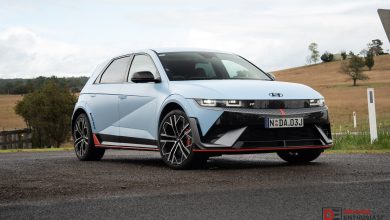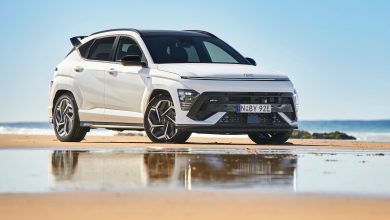From its bar-of-soap-inspired streamliner design, to the large active aero flaps in the front end, to its insanely spacious interior, the 2023 Hyundai IONIQ 6 is certainly an interesting newcomer in the world of electric vehicles.
Add plenty of relentless power and an impressive range and you’ve got yourself a tasty driver’s treat, too. But is it the EV to have?

2023 Hyundai IONIQ 6 EPIQ: Specifications
Battery: 77.4kWh lithium-ion, 800V
Output: 239kW / 605Nm
Gearbox: Single-speed auto
Drive type: All-wheel drive
Wheels: F & R: 20×8.5, 245/40
ANCAP: Five stars
Tare weight: 2078kg
Power-to-weight: 8.69:1 (kg:kW)
Official range: 519km
Max charging: 350kW DC, 11kW AC0-60km/h: 2.46 seconds*
0-100km/h: 4.94 seconds*
60-110km/h: 3.22 seconds*
1/4 mile: 13.38 seconds at 167.9km/h*
Max acceleration: 0.902g*
100-0km/h braking: 37.72m in 2.90 seconds*
Max deceleration: -1.187g*
Decibel at idle (standby): 23*
Peak decibel at 60-100km/h: 68*
Starting price: $87,288
*Figures as tested by Driving Enthusiast on the day. Manufacturers’ claims may be different
2023 Hyundai IONIQ 6 EPIQ: How much does it cost?
We’re not sure why it is priced so high, but it could turn away some buyers. You see, this flagship EPIQ starts from $87,288. That’s about $11k more than the more powerful Polestar 2 rival, and more than some Telsa Model 3 variants. In fact, it is perilously close to the German veterans; Audi A4, BMW 3 Series, Mercedes C-Class.
Going for the entry model leaves you with rear-wheel drive, but the range is a whopping 614km, which is impressive for this class. The price also drops significantly, down to a more palatable $74,000 (excluding on-roads). If 0-100 performance and all-wheel drive are important to you then you need the EPIQ or the mid-level TECHNIQ (from $83,500). But if range and economy are higher on the priorities then it is worth investigating the base DYNAMIQ.

2023 Hyundai IONIQ 6 EPIQ: Interior & packaging
This is a very interesting interior. It’s open and spacious, and the design is a blend of conventional practicality mixed with quirky modernity. The wheelbase spans a whopping 2.95m long. It’s about the same length wheelbase as the latest BMW 5 Series. So it’s no wonder there is so much room in here.
All controls and functions are presented in a logical arrangement, as per usual with Hyundai vehicles, with twin 12.3-inch digital screens attached along the dash. The interface is simple and intuitive and comes jam-packed with apps, including digital radio, some interesting ‘EV’ driving menus and statistics, and Android Auto and Apple CarPlay.
General storage is plentiful, with the usual cup and bottle holders, and a centre console box. You’ve also got a large trough/tray under the centre console, although, it’s probably more useful as a mini bowling alley because there are no partitions to stop things sliding up and down.

The IONIQ 6 is available with digital side mirrors – basically, cameras instead mirrors. These come standard on this top EPIQ model, however, we can’t seem to find good use for them; you can’t lean forward to see more view, and clarity at night is very poor. They probably improve aerodynamics but there doesn’t seem to be any hard data out there to confirm.
Rear seat space is really impressive. This is like a Mercedes S-Class. Well, almost. The floor is completely flat, boosting the perception of spaciousness, and the gap between the bench and the front seats is huge. Climate vents and charging ports come as standard. Although some of the plastics in the IONIQ 6 are made from recycled materials, various areas feel a bit cheap and scratchy, particularly the door trims.
Up at the back you have a fairly large boot if you want to class this as a coupe, or average space if you class it as a sedan. It measures 401L. You can fold down the rear seats for extra length, and there’s a little bit of storage under the floor.
Another storage box is located under the bonnet at the front, but it only presents 14.5 litres in the twin-motor AWD configuration. The rear-wheel drive version offers 45 litres.

2023 Hyundai IONIQ 6 EPIQ: Powertrain & handling
Under the sleek exterior lies a 77.4kWh lithium-ion battery and 800V electrical system. It sends energy to two electric motors. The front-axle motor produces 74kW while the rear-axle motor generates 165kW. Combined, the pair offer an impressive 239kW and 605Nm.
On a private road we clocked 0-100km/h in just 4.94 seconds using a Racelogic Vbox. We also saw the quarter-mile come up in a dashing 13.38 seconds. This is a quick car. However, by EV standards, particularly top-spec standards, the performance is only average.
Fortunately there is more to the IONIQ 6 than straight-line acceleration. With all-wheel drive capability and the instant availability of power and torque, the IONIQ 6 offers exhilarating handling. The instant torque from the electric motors provide an immediate corner-exit pounce, allowing you to burst between bends and keep up a galloping – and fun – pace.

The IONIQ 6 EPIQ impresses with its smooth and composed ride. The suspension soaks up bumps and imperfections, providing a comfortable journey for passengers. When pushed hard over bumpy corners you can feel a brake-type torque vectoring characteristic, but it’s not as prominent as the IONIQ 5. This could be due to the 6’s lower centre of gravity.
Overall, it’s not quite as engaging or as composed as some of its official rivals – such as the BMW 3 Series, Mercedes C-Class, and Polestar 2 – when pushed to its limits. Part of the blame has to be its 2078kg tare weight. It’s not a sports car, we get that, but we’d like to see an optional ‘N Line’ suspension package for driving fans.
In terms of range, the IONIQ 6 EPIQ doesn’t disappoint. The EPIQ is rated at 519km. That’s plenty enough to support daily commuting with a recharge once per week. Obviously if you’re out and about on the weekends or take part in other activities before or after work, you might need a short top up mid-week.

2023 Hyundai IONIQ 6 EPIQ: Key attractions/reasons to buy
The IONIQ 6 EPIQ is a head-turner. Its futuristic styling, with smooth, curvy lines and a distinctive swooping profile set it apart from the crowd. Hyundai has managed to blend aesthetics with aerodynamics, resulting in a vehicle that not only looks intriguing but also one that cuts through the air efficiently, contributing to its impressive range. It’s actually the most aerodynamic Hyundai ever, with a drag coefficient value of just 0.21.
Inside, the use of eco-friendly materials and whatnot is a step in the right direction. They might feel a bit cheap and basic but if they help clean up the environment then that can only be a good thing. It also shows innovation from the brand, even if it is a bit of a marketing exercise as well.
Technology and futurism are definitely the most enticing characteristics of this car. So, for savvy buyers, it should be an alluring factor. With digital side mirrors as standard, an ingeniously spacious yet simplistic interior, and an 800V electrical system (pretty rare in this class), the IONIQ 6 is a very modern vehicle.

2023 Hyundai IONIQ 6 EPIQ: Key considerations before you buy
According to a website called Google, the average price of electricity in Australia at the time of writing is $0.358 per kWh. So, this 77.4kWh battery, from empty, will cost you $27.71 to recharge at home. That’s excluding off-peak discounts and other factors.
Using that interesting website called Google, it seems the average home in Sydney uses around 12-15kWh of electricity per day. That means to recharge an electric vehicle with a battery capacity of around 77kWh, it will cost you around 5 days worth of household electricity.
It’s also worth considering where that electricity comes from. Obviously the ‘greenest’ way to do this is to have solar panels on your home and then only recharge the vehicle during the day; solar panels are just ornaments at night.
But, if you aren’t able to charge during the day because you’re at work, and if you don’t have solar panels because you live in an apartment, then it is worth thinking about how much ‘dirty’ energy the vehicle is requiring every week if you can only charge at night. Most electricity from the grid in Australia still comes from something being burned, and this process is not in sync with what EVs portray.

If, on the other hand, you couldn’t give a shit about being green and just want a fast car that looks cool and only costs $27 per week to charge up (potentially), then yes, this is a very appealing package.
The other main factory to consider is its price. From near-$90,000, it is a big spend. For this sort of money you can get a reasonably high level Audi A4 or a BMW 3 Series. More importantly, you could also get a Tesla Model 3 or a Polestar 2 with change leftover.
Choosing between the single-motor and dual-motor variants could be an influencing decision, too. While the single-motor offers respectable performance but an awesome electric range (614km), the dual-motor configuration delivers a more exciting driving experience. You’ll have to weigh your priorities to see what suits you best.
2023 Hyundai IONIQ 6 EPIQ: Video
How does it rate against its rivals?
- Price
- Quality look & feel
- Interior tech
- Powertrain performance
- Ride & handling
- X factor (does it stand out in its class?)
Final word
The IONIQ 6 is a compelling option for those seeking a green and very modern vehicle that immediately advertises these attitudes. It’s enjoyable to drive, innovative, and offers an impressive range for its class. But take your time deciding on which variant suits your needs and driving style, and budget.























